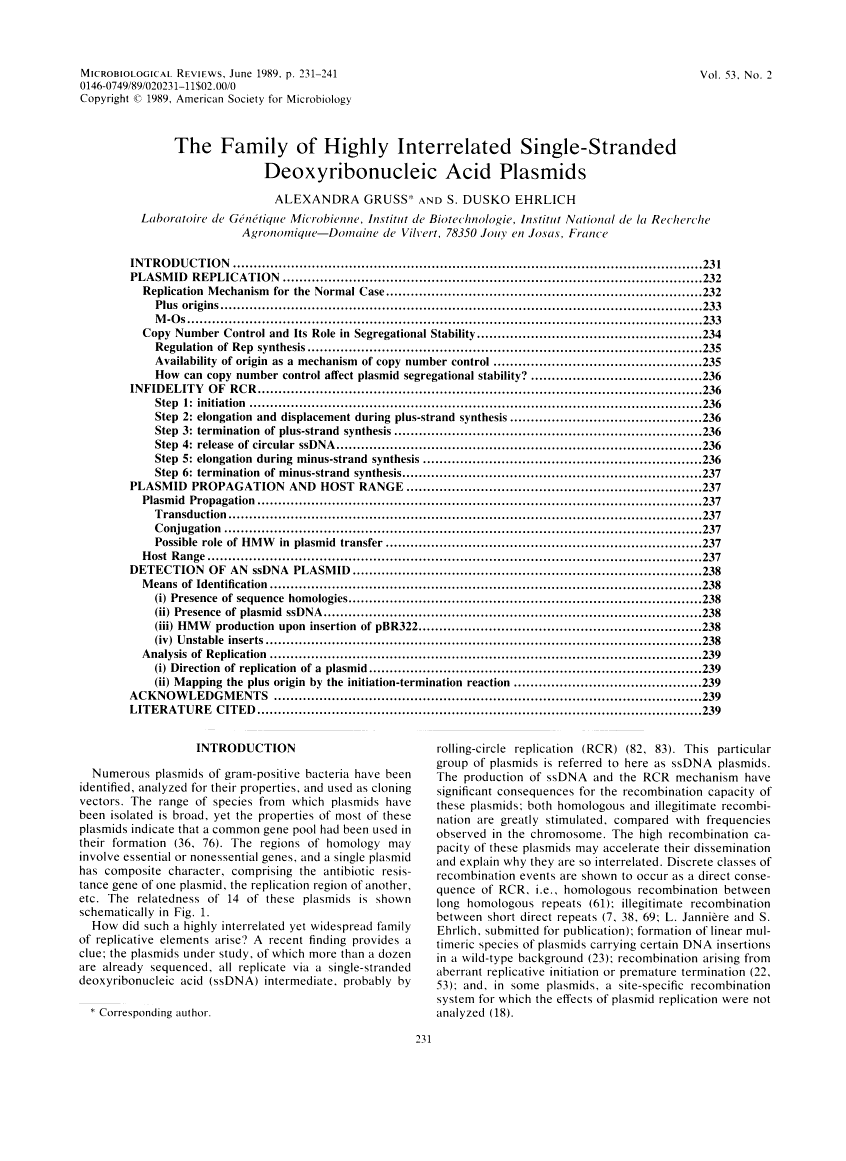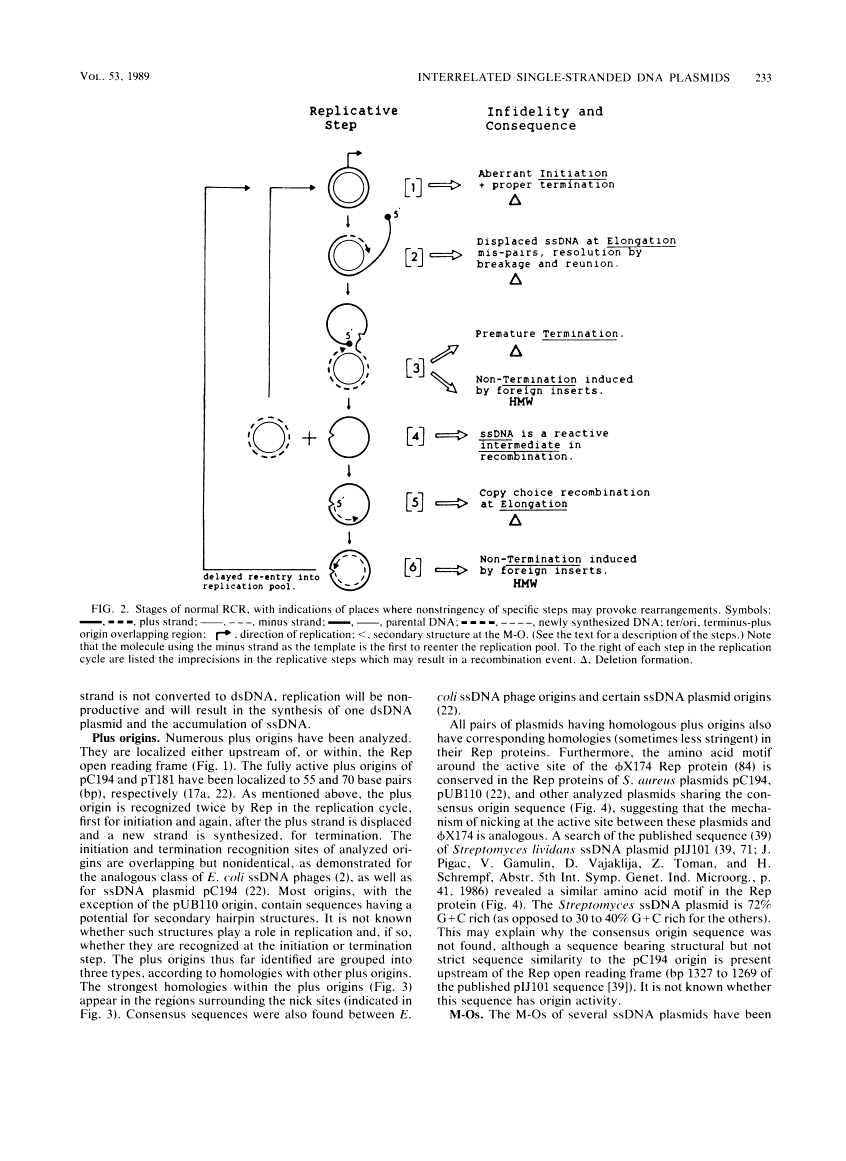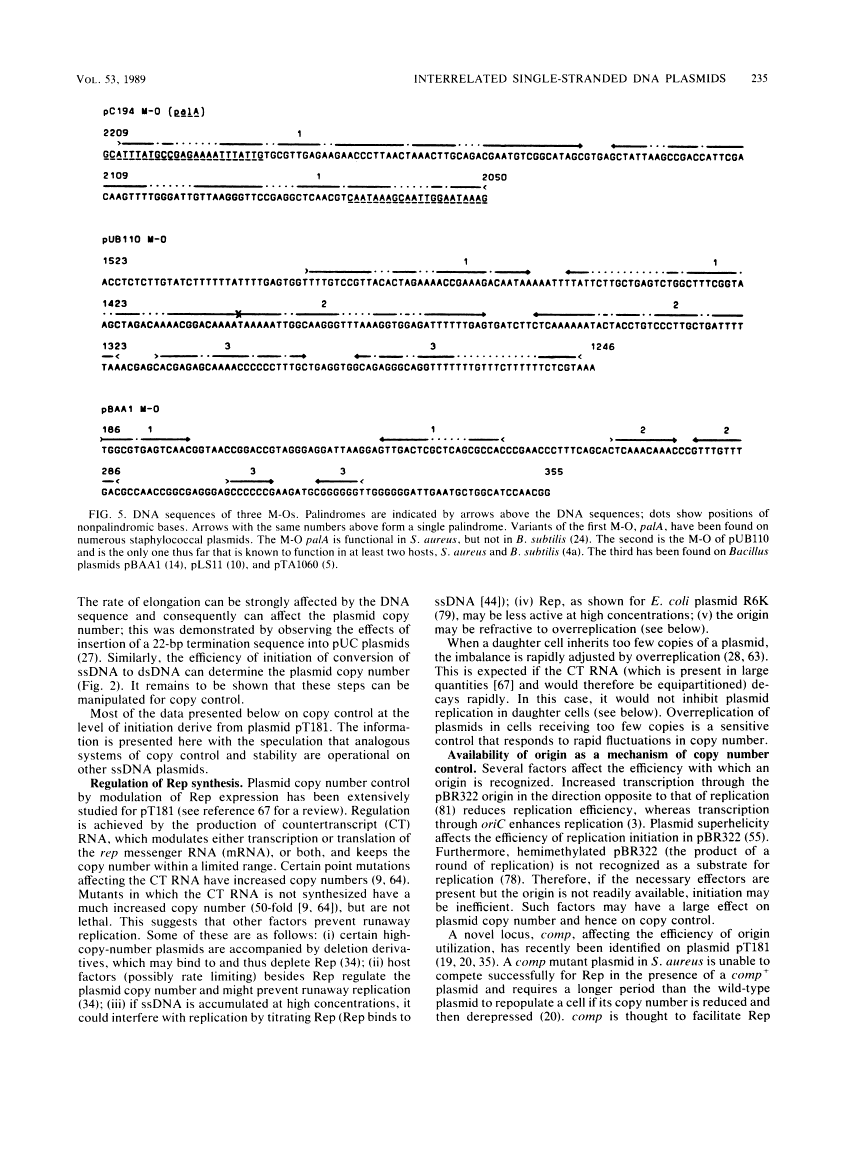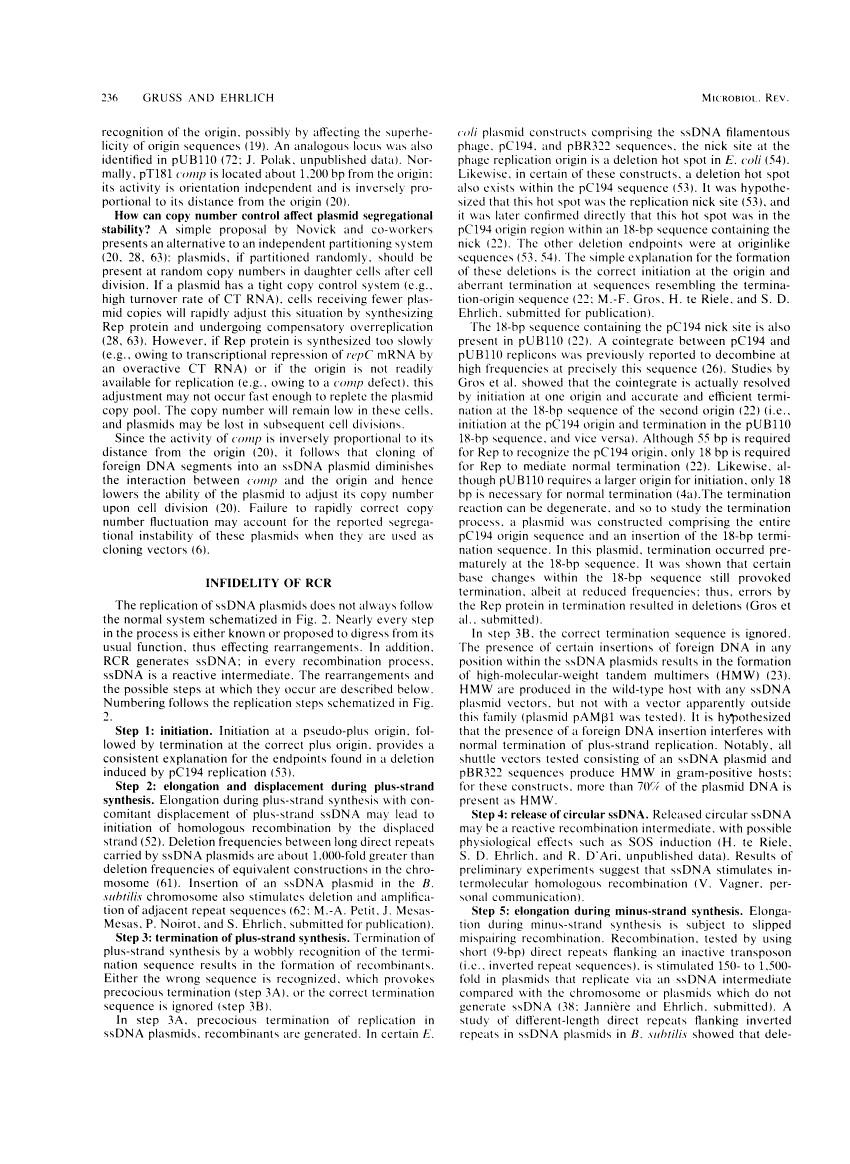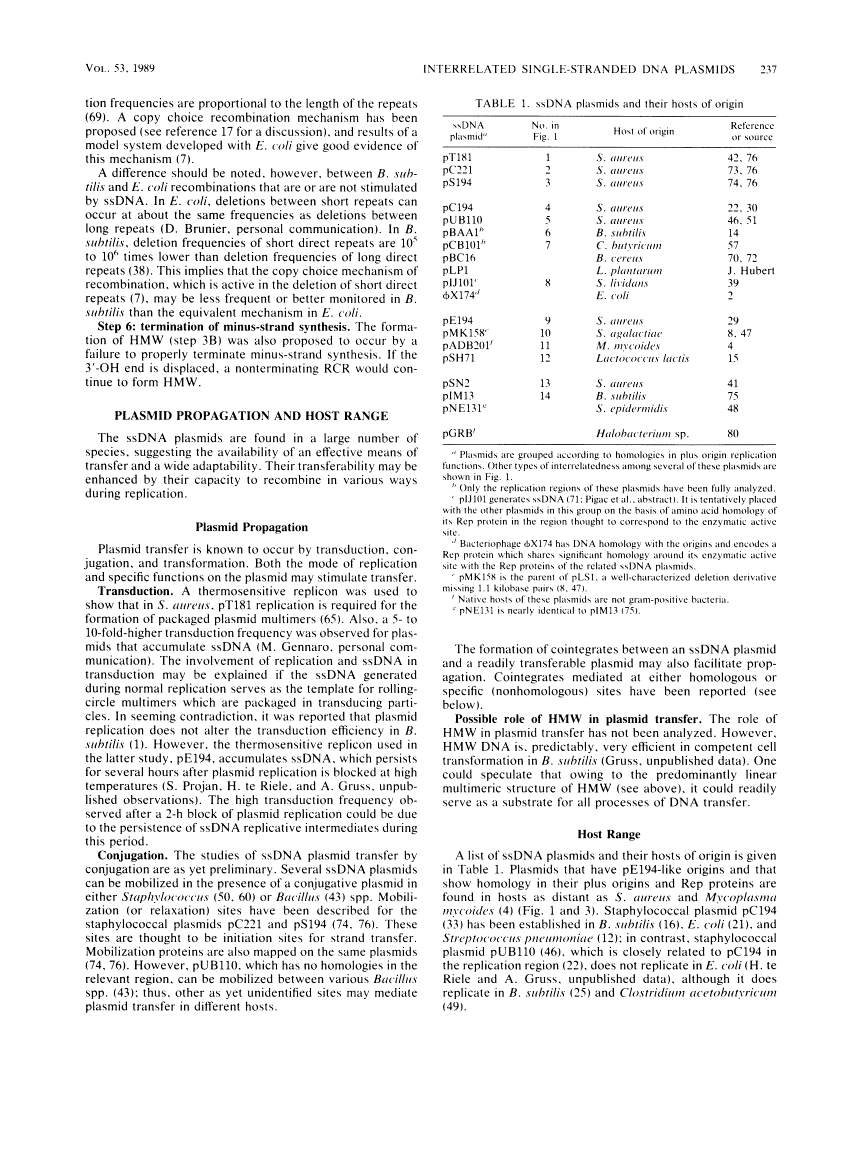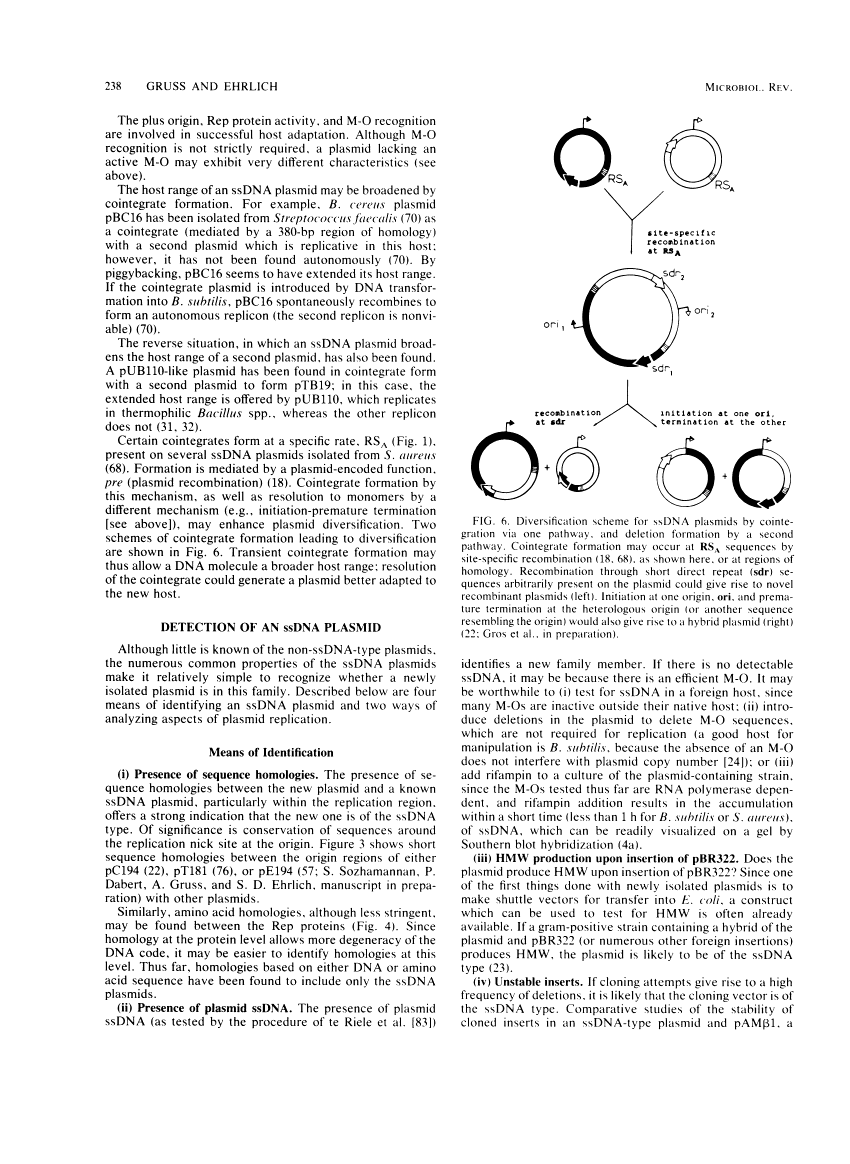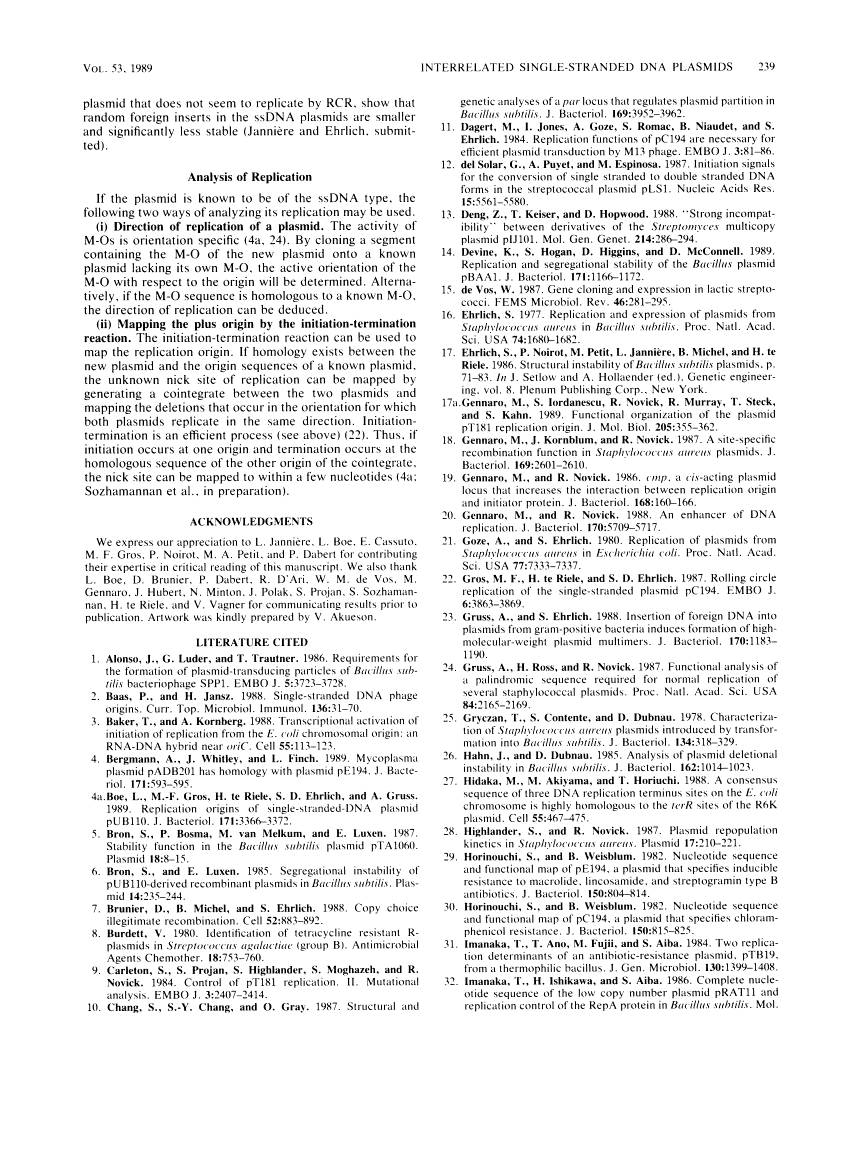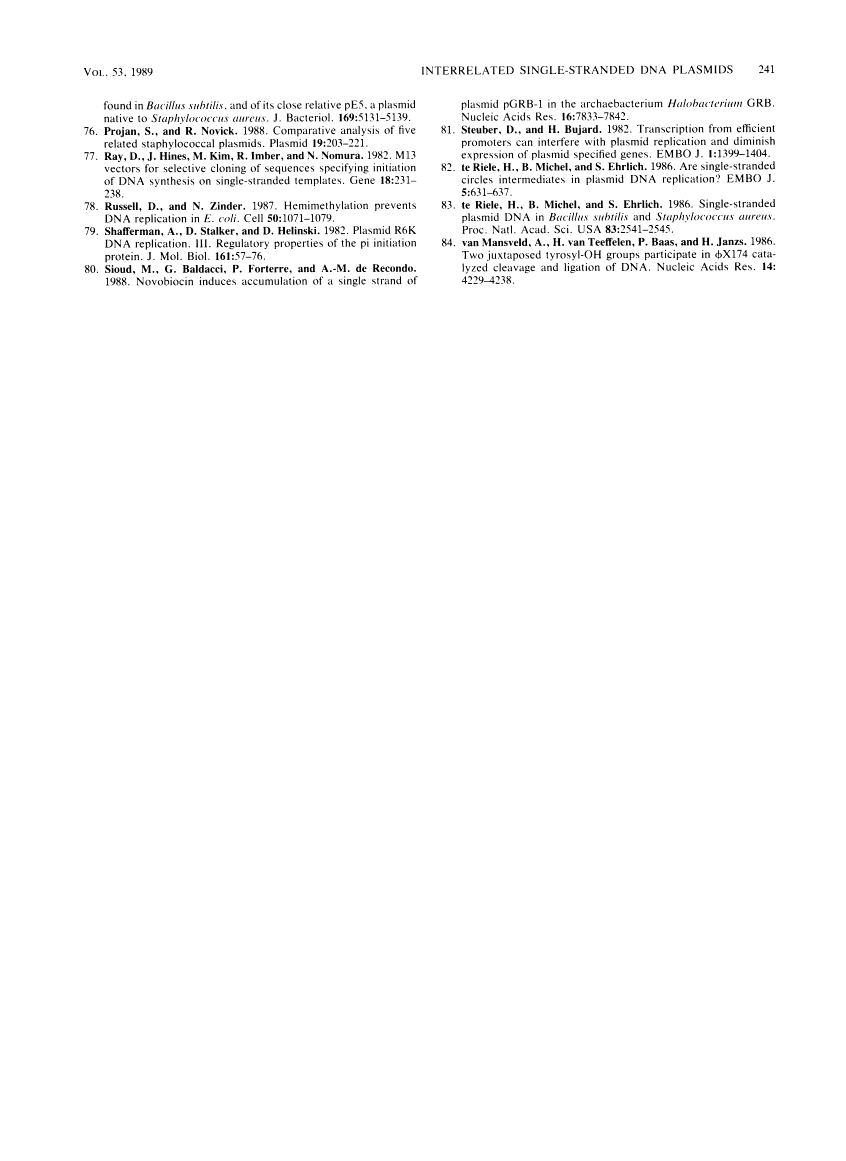Abstract
Free full text

The family of highly interrelated single-stranded deoxyribonucleic acid plasmids.
Abstract
Many plasmids from gram-positive bacteria replicate via a single-stranded deoxyribonucleic acid (ssDNA) intermediate, most probably by a rolling-circle mechanism (these plasmids are referred to in this paper as ssDNA plasmids). Their plus and minus origins are physically separated, and replicative initiations are not simultaneous; it is this feature that allows visualization of ssDNA replication intermediates. The insertion of foreign DNA into an ssDNA plasmid may provoke a high frequency of deletions, changes of replicative products to high-molecular-weight forms, segregational loss, and decreased plasmid copy numbers. When an ssDNA plasmid is inserted into the chromosome, both deletions and amplifications may be induced. Both the mode of replication and the copy control mechanism affect the fate of inserted foreign material, usually selecting for its loss. Thus, after having tasted various morsels of DNA, the resulting plasmid stays trim. The features of the ssDNA plasmids seem to be beneficial for their viability and propagation, but not for their use as cloning vectors. However, plasmids replicating via ssDNA intermediates are being exploited to yield insights into the mechanisms of recombination and amplification.
Full text
Full text is available as a scanned copy of the original print version. Get a printable copy (PDF file) of the complete article (1.9M), or click on a page image below to browse page by page. Links to PubMed are also available for Selected References.
Selected References
These references are in PubMed. This may not be the complete list of references from this article.
- Alonso JC, Lüder G, Trautner TA. Requirements for the formation of plasmid-transducing particles of Bacillus subtilis bacteriophage SPP1. EMBO J. 1986 Dec 20;5(13):3723–3728. [Europe PMC free article] [Abstract] [Google Scholar]
- Baas PD, Jansz HS. Single-stranded DNA phage origins. Curr Top Microbiol Immunol. 1988;136:31–70. [Abstract] [Google Scholar]
- Baker TA, Kornberg A. Transcriptional activation of initiation of replication from the E. coli chromosomal origin: an RNA-DNA hybrid near oriC. Cell. 1988 Oct 7;55(1):113–123. [Abstract] [Google Scholar]
- Bergemann AD, Whitley JC, Finch LR. Homology of mycoplasma plasmid pADB201 and staphylococcal plasmid pE194. J Bacteriol. 1989 Jan;171(1):593–595. [Europe PMC free article] [Abstract] [Google Scholar]
- Boe L, Gros MF, te Riele H, Ehrlich SD, Gruss A. Replication origins of single-stranded-DNA plasmid pUB110. J Bacteriol. 1989 Jun;171(6):3366–3372. [Europe PMC free article] [Abstract] [Google Scholar]
- Bron S, Bosma P, van Belkum M, Luxen E. Stability function in the Bacillus subtilis plasmid pTA 1060. Plasmid. 1987 Jul;18(1):8–15. [Abstract] [Google Scholar]
- Bron S, Luxen E. Segregational instability of pUB110-derived recombinant plasmids in Bacillus subtilis. Plasmid. 1985 Nov;14(3):235–244. [Abstract] [Google Scholar]
- Brunier D, Michel B, Ehrlich SD. Copy choice illegitimate DNA recombination. Cell. 1988 Mar 25;52(6):883–892. [Abstract] [Google Scholar]
- Burdett V. Identification of tetracycline-resistant R-plasmids in Streptococcus agalactiae (group B). Antimicrob Agents Chemother. 1980 Nov;18(5):753–760. [Europe PMC free article] [Abstract] [Google Scholar]
- Carleton S, Projan SJ, Highlander SK, Moghazeh SM, Novick RP. Control of pT181 replication II. Mutational analysis. EMBO J. 1984 Oct;3(10):2407–2414. [Europe PMC free article] [Abstract] [Google Scholar]
- Chang S, Chang SY, Gray O. Structural and genetic analyses of a par locus that regulates plasmid partition in Bacillus subtilis. J Bacteriol. 1987 Sep;169(9):3952–3962. [Europe PMC free article] [Abstract] [Google Scholar]
- Dagert M, Jones I, Goze A, Romac S, Niaudet B, Ehrlich SD. Replication functions of pC194 are necessary for efficient plasmid transduction by M13 phage. EMBO J. 1984 Jan;3(1):81–86. [Europe PMC free article] [Abstract] [Google Scholar]
- del Solar GH, Puyet A, Espinosa M. Initiation signals for the conversion of single stranded to double stranded DNA forms in the streptococcal plasmid pLS1. Nucleic Acids Res. 1987 Jul 24;15(14):5561–5580. [Europe PMC free article] [Abstract] [Google Scholar]
- Deng ZX, Kieser T, Hopwood DA. "Strong incompatibility" between derivatives of the Streptomyces multi-copy plasmid pIJ101. Mol Gen Genet. 1988 Oct;214(2):286–294. [Abstract] [Google Scholar]
- Devine KM, Hogan ST, Higgins DG, McConnell DJ. Replication and segregational stability of Bacillus plasmid pBAA1. J Bacteriol. 1989 Feb;171(2):1166–1172. [Europe PMC free article] [Abstract] [Google Scholar]
- Ehrlich SD. Replication and expression of plasmids from Staphylococcus aureus in Bacillus subtilis. Proc Natl Acad Sci U S A. 1977 Apr;74(4):1680–1682. [Europe PMC free article] [Abstract] [Google Scholar]
- Gennaro ML, Iordanescu S, Novick RP, Murray RW, Steck TR, Khan SA. Functional organization of the plasmid pT181 replication origin. J Mol Biol. 1989 Jan 20;205(2):355–362. [Abstract] [Google Scholar]
- Gennaro ML, Kornblum J, Novick RP. A site-specific recombination function in Staphylococcus aureus plasmids. J Bacteriol. 1987 Jun;169(6):2601–2610. [Europe PMC free article] [Abstract] [Google Scholar]
- Gennaro ML, Novick RP. cmp, a cis-acting plasmid locus that increases interaction between replication origin and initiator protein. J Bacteriol. 1986 Oct;168(1):160–166. [Europe PMC free article] [Abstract] [Google Scholar]
- Gennaro ML, Novick RP. An enhancer of DNA replication. J Bacteriol. 1988 Dec;170(12):5709–5717. [Europe PMC free article] [Abstract] [Google Scholar]
- Goze A, Ehrlich SD. Replication of plasmids from Staphylococcus aureus in Escherichia coli. Proc Natl Acad Sci U S A. 1980 Dec;77(12):7333–7337. [Europe PMC free article] [Abstract] [Google Scholar]
- Gros MF, te Riele H, Ehrlich SD. Rolling circle replication of single-stranded DNA plasmid pC194. EMBO J. 1987 Dec 1;6(12):3863–3869. [Europe PMC free article] [Abstract] [Google Scholar]
- Gruss A, Ehrlich SD. Insertion of foreign DNA into plasmids from gram-positive bacteria induces formation of high-molecular-weight plasmid multimers. J Bacteriol. 1988 Mar;170(3):1183–1190. [Europe PMC free article] [Abstract] [Google Scholar]
- Gruss AD, Ross HF, Novick RP. Functional analysis of a palindromic sequence required for normal replication of several staphylococcal plasmids. Proc Natl Acad Sci U S A. 1987 Apr;84(8):2165–2169. [Europe PMC free article] [Abstract] [Google Scholar]
- Gryczan TJ, Contente S, Dubnau D. Characterization of Staphylococcus aureus plasmids introduced by transformation into Bacillus subtilis. J Bacteriol. 1978 Apr;134(1):318–329. [Europe PMC free article] [Abstract] [Google Scholar]
- Hahn J, Dubnau D. Analysis of plasmid deletional instability in Bacillus subtilis. J Bacteriol. 1985 Jun;162(3):1014–1023. [Europe PMC free article] [Abstract] [Google Scholar]
- Hidaka M, Akiyama M, Horiuchi T. A consensus sequence of three DNA replication terminus sites on the E. coli chromosome is highly homologous to the terR sites of the R6K plasmid. Cell. 1988 Nov 4;55(3):467–475. [Abstract] [Google Scholar]
- Highlander SK, Novick RP. Plasmid repopulation kinetics in Staphylococcus aureus. Plasmid. 1987 May;17(3):210–221. [Abstract] [Google Scholar]
- Horinouchi S, Weisblum B. Nucleotide sequence and functional map of pE194, a plasmid that specifies inducible resistance to macrolide, lincosamide, and streptogramin type B antibodies. J Bacteriol. 1982 May;150(2):804–814. [Europe PMC free article] [Abstract] [Google Scholar]
- Horinouchi S, Weisblum B. Nucleotide sequence and functional map of pC194, a plasmid that specifies inducible chloramphenicol resistance. J Bacteriol. 1982 May;150(2):815–825. [Europe PMC free article] [Abstract] [Google Scholar]
- Imanaka T, Ano T, Fujii M, Aiba S. Two replication determinants of an antibiotic-resistance plasmid, pTB19, from a thermophilic bacillus. J Gen Microbiol. 1984 Jun;130(6):1399–1408. [Abstract] [Google Scholar]
- Iordănescu S. Three distinct plasmids originating in the same Staphylococcus aureus strain. Arch Roum Pathol Exp Microbiol. 1976 Jan-Jun;35(1-2):111–118. [Abstract] [Google Scholar]
- Iordanescu S. Staphylococcus aureus chromosomal mutation specifically affecting the copy number of Inc3 plasmids. Plasmid. 1983 Sep;10(2):130–137. [Abstract] [Google Scholar]
- Iordanescu S. Effect of the deletion of a fragment dispensable for the autonomous maintenance of plasmid pT181 on the competition between incompatible plasmids. Plasmid. 1986 May;15(3):191–198. [Abstract] [Google Scholar]
- Iordanescu S, Surdeanu M, Della Latta P, Novick R. Incompatibility and molecular relationships between small Staphylococcal plasmids carrying the same resistance marker. Plasmid. 1978 Sep;1(4):468–479. [Abstract] [Google Scholar]
- Jannière L, Ehrlich SD. Recombination between short repeated sequences is more frequent in plasmids than in the chromosome of Bacillus subtilis. Mol Gen Genet. 1987 Nov;210(1):116–121. [Abstract] [Google Scholar]
- Kendall KJ, Cohen SN. Complete nucleotide sequence of the Streptomyces lividans plasmid pIJ101 and correlation of the sequence with genetic properties. J Bacteriol. 1988 Oct;170(10):4634–4651. [Europe PMC free article] [Abstract] [Google Scholar]
- Khan SA, Murray RW, Koepsel RR. Mechanism of plasmid pT181 DNA replication. Biochim Biophys Acta. 1988 Dec 20;951(2-3):375–381. [Abstract] [Google Scholar]
- Khan SA, Novick RP. Structural analysis of plasmid pSN2 in Staphylococcus aureus: no involvement in enterotoxin B production. J Bacteriol. 1982 Feb;149(2):642–649. [Europe PMC free article] [Abstract] [Google Scholar]
- Khan SA, Novick RP. Complete nucleotide sequence of pT181, a tetracycline-resistance plasmid from Staphylococcus aureus. Plasmid. 1983 Nov;10(3):251–259. [Abstract] [Google Scholar]
- Koehler TM, Thorne CB. Bacillus subtilis (natto) plasmid pLS20 mediates interspecies plasmid transfer. J Bacteriol. 1987 Nov;169(11):5271–5278. [Europe PMC free article] [Abstract] [Google Scholar]
- Koepsel RR, Khan SA. Cleavage of single-stranded DNA by plasmid pT181-encoded RepC protein. Nucleic Acids Res. 1987 May 26;15(10):4085–4097. [Europe PMC free article] [Abstract] [Google Scholar]
- Koepsel RR, Murray RW, Rosenblum WD, Khan SA. The replication initiator protein of plasmid pT181 has sequence-specific endonuclease and topoisomerase-like activities. Proc Natl Acad Sci U S A. 1985 Oct;82(20):6845–6849. [Europe PMC free article] [Abstract] [Google Scholar]
- Lacey RW, Chopra I. Genetic studies of a multi-resistant strain of Staphylococcus aureus. J Med Microbiol. 1974 May;7(2):285–297. [Abstract] [Google Scholar]
- Lacks SA, Lopez P, Greenberg B, Espinosa M. Identification and analysis of genes for tetracycline resistance and replication functions in the broad-host-range plasmid pLS1. J Mol Biol. 1986 Dec 20;192(4):753–765. [Abstract] [Google Scholar]
- Lampson BC, Parisi JT. Nucleotide sequence of the constitutive macrolide-lincosamide-streptogramin B resistance plasmid pNE131 from Staphylococcus epidermidis and homologies with Staphylococcus aureus plasmids pE194 and pSN2. J Bacteriol. 1986 Sep;167(3):888–892. [Europe PMC free article] [Abstract] [Google Scholar]
- Lin YL, Blaschek HP. Transformation of Heat-Treated Clostridium acetobutylicum Protoplasts with pUB110 Plasmid DNA. Appl Environ Microbiol. 1984 Oct;48(4):737–742. [Europe PMC free article] [Abstract] [Google Scholar]
- McDonnell RW, Sweeney HM, Cohen S. Conjugational transfer of gentamicin resistance plasmids intra- and interspecifically in Staphylococcus aureus and Staphylococcus epidermidis. Antimicrob Agents Chemother. 1983 Jan;23(1):151–160. [Europe PMC free article] [Abstract] [Google Scholar]
- McKenzie T, Hoshino T, Tanaka T, Sueoka N. The nucleotide sequence of pUB110: some salient features in relation to replication and its regulation. Plasmid. 1986 Mar;15(2):93–103. [Abstract] [Google Scholar]
- Meselson MS, Radding CM. A general model for genetic recombination. Proc Natl Acad Sci U S A. 1975 Jan;72(1):358–361. [Europe PMC free article] [Abstract] [Google Scholar]
- Michel B, Ehrlich SD. Illegitimate recombination occurs between the replication origin of the plasmid pC194 and a progressing replication fork. EMBO J. 1986 Dec 20;5(13):3691–3696. [Europe PMC free article] [Abstract] [Google Scholar]
- Michel B, Ehrlich SD. Illegitimate recombination at the replication origin of bacteriophage M13. Proc Natl Acad Sci U S A. 1986 May;83(10):3386–3390. [Europe PMC free article] [Abstract] [Google Scholar]
- Minden JS, Marians KJ. Replication of pBR322 DNA in vitro with purified proteins. Requirement for topoisomerase I in the maintenance of template specificity. J Biol Chem. 1985 Aug 5;260(16):9316–9325. [Abstract] [Google Scholar]
- Minton NP, Oultram JD, Brehm JK, Atkinson T. The replication proteins of plasmids pE194 and pLS1 have N-terminal homology. Nucleic Acids Res. 1988 Apr 11;16(7):3101–3101. [Europe PMC free article] [Abstract] [Google Scholar]
- Muller RE, Ano T, Imanaka T, Aiba S. Complete nucleotide sequences of Bacillus plasmids pUB110dB, pRBH1 and its copy mutants. Mol Gen Genet. 1986 Jan;202(1):169–171. [Abstract] [Google Scholar]
- Naidoo J. Interspecific co-transfer of antibiotic resistance plasmids in staphylococci in vivo. J Hyg (Lond) 1984 Aug;93(1):59–66. [Europe PMC free article] [Abstract] [Google Scholar]
- Niaudet B, Jannière L, Ehrlich SD. Recombination between repeated DNA sequences occurs more often in plasmids than in the chromosome of Bacillus subtilis. Mol Gen Genet. 1984;197(1):46–54. [Abstract] [Google Scholar]
- Noirot P, Petit MA, Ehrlich SD. Plasmid replication stimulates DNA recombination in Bacillus subtilis. J Mol Biol. 1987 Jul 5;196(1):39–48. [Abstract] [Google Scholar]
- Novick RP. Plasmid incompatibility. Microbiol Rev. 1987 Dec;51(4):381–395. [Europe PMC free article] [Abstract] [Google Scholar]
- Novick RP, Adler GK, Projan SJ, Carleton S, Highlander SK, Gruss A, Khan SA, Iordanescu S. Control of pT181 replication I. The pT181 copy control function acts by inhibiting the synthesis of a replication protein. EMBO J. 1984 Oct;3(10):2399–2405. [Europe PMC free article] [Abstract] [Google Scholar]
- Novick RP, Edelman I, Lofdahl S. Small Staphylococcus aureus plasmids are transduced as linear multimers that are formed and resolved by replicative processes. J Mol Biol. 1986 Nov 20;192(2):209–220. [Abstract] [Google Scholar]
- Novick RP, Projan SJ, Kumar CC, Carleton S, Gruss A, Highlander SK, Kornblum J. Replication control for pT181, an indirectly regulated plasmid. Basic Life Sci. 1985;30:299–320. [Abstract] [Google Scholar]
- Novick RP, Projan SJ, Rosenblum W, Edelman I. Staphylococcal plasmid cointegrates are formed by host- and phage-mediated general rec systems that act on short regions of homology. Mol Gen Genet. 1984;195(1-2):374–377. [Abstract] [Google Scholar]
- Peeters BP, de Boer JH, Bron S, Venema G. Structural plasmid instability in Bacillus subtilis: effect of direct and inverted repeats. Mol Gen Genet. 1988 Jun;212(3):450–458. [Abstract] [Google Scholar]
- Perkins JB, Youngman P. Streptococcus plasmid pAM alpha 1 is a composite of two separable replicons, one of which is closely related to Bacillus plasmid pBC16. J Bacteriol. 1983 Aug;155(2):607–615. [Europe PMC free article] [Abstract] [Google Scholar]
- Pigac J, Vujaklija D, Toman Z, Gamulin V, Schrempf H. Structural instability of a bifunctional plasmid pZG1 and single-stranded DNA formation in Streptomyces. Plasmid. 1988 May;19(3):222–230. [Abstract] [Google Scholar]
- Polak J, Novick RP. Closely related plasmids from Staphylococcus aureus and soil bacilli. Plasmid. 1982 Mar;7(2):152–162. [Abstract] [Google Scholar]
- Projan SJ, Kornblum J, Moghazeh SL, Edelman I, Gennaro ML, Novick RP. Comparative sequence and functional analysis of pT181 and pC221, cognate plasmid replicons from Staphylococcus aureus. Mol Gen Genet. 1985;199(3):452–464. [Abstract] [Google Scholar]
- Projan SJ, Moghazeh S, Novick RP. Nucleotide sequence of pS194, a streptomycin-resistance plasmid from Staphylococcus aureus. Nucleic Acids Res. 1988 Mar 25;16(5):2179–2187. [Europe PMC free article] [Abstract] [Google Scholar]
- Projan SJ, Monod M, Narayanan CS, Dubnau D. Replication properties of pIM13, a naturally occurring plasmid found in Bacillus subtilis, and of its close relative pE5, a plasmid native to Staphylococcus aureus. J Bacteriol. 1987 Nov;169(11):5131–5139. [Europe PMC free article] [Abstract] [Google Scholar]
- Projan SJ, Novick R. Comparative analysis of five related Staphylococcal plasmids. Plasmid. 1988 May;19(3):203–221. [Abstract] [Google Scholar]
- Ray DS, Hines JC, Kim MH, Imber R, Nomura N. M13 vectors for selective cloning of sequences specifying initiation of DNA synthesis on single-stranded templates. Gene. 1982 Jun;18(3):231–238. [Abstract] [Google Scholar]
- Russell DW, Zinder ND. Hemimethylation prevents DNA replication in E. coli. Cell. 1987 Sep 25;50(7):1071–1079. [Abstract] [Google Scholar]
- Shafferman A, Kolter R, Stalker D, Helinski DR. Plasmid R6K DNA replication. III. Regulatory properties of the pi initiation protein. J Mol Biol. 1982 Oct 15;161(1):57–76. [Abstract] [Google Scholar]
- Sioud M, Baldacci G, Forterre P, de Recondo AM. Novobiocin induces accumulation of a single strand of plasmid pGRB-1 in the archaebacterium Halobacterium GRB. Nucleic Acids Res. 1988 Aug 25;16(16):7833–7842. [Europe PMC free article] [Abstract] [Google Scholar]
- Stueber D, Bujard H. Transcription from efficient promoters can interfere with plasmid replication and diminish expression of plasmid specified genes. EMBO J. 1982;1(11):1399–1404. [Europe PMC free article] [Abstract] [Google Scholar]
- te Riele H, Michel B, Ehrlich SD. Are single-stranded circles intermediates in plasmid DNA replication? EMBO J. 1986 Mar;5(3):631–637. [Europe PMC free article] [Abstract] [Google Scholar]
- te Riele H, Michel B, Ehrlich SD. Single-stranded plasmid DNA in Bacillus subtilis and Staphylococcus aureus. Proc Natl Acad Sci U S A. 1986 Apr;83(8):2541–2545. [Europe PMC free article] [Abstract] [Google Scholar]
- van Mansfeld AD, van Teeffelen HA, Baas PD, Jansz HS. Two juxtaposed tyrosyl-OH groups participate in phi X174 gene A protein catalysed cleavage and ligation of DNA. Nucleic Acids Res. 1986 May 27;14(10):4229–4238. [Europe PMC free article] [Abstract] [Google Scholar]
Associated Data
Articles from Microbiological Reviews are provided here courtesy of American Society for Microbiology (ASM)
Full text links
Read article at publisher's site: https://doi.org/10.1128/mr.53.2.231-241.1989
Read article for free, from open access legal sources, via Unpaywall:
https://mmbr.asm.org/content/mmbr/53/2/231.full.pdf
Citations & impact
Impact metrics
Article citations
Watson-Crick Base-Pairing Requirements for ssDNA Recognition and Processing in Replication-Initiating HUH Endonucleases.
mBio, 14(1):e0258722, 21 Dec 2022
Cited by: 4 articles | PMID: 36541758 | PMCID: PMC9973303
Characterization of a novel theta-type replicon of indigenous plasmid pTE15 from Lactobacillus reuteri N16.
BMC Microbiol, 22(1):298, 12 Dec 2022
Cited by: 0 articles | PMID: 36510154 | PMCID: PMC9743546
Fluorescence Tools Adapted for Real-Time Monitoring of the Behaviors of Streptococcus Species.
Appl Environ Microbiol, 85(15):e00620-19, 18 Jul 2019
Cited by: 16 articles | PMID: 31101614 | PMCID: PMC6643251
Replication of Staphylococcal Resistance Plasmids.
Front Microbiol, 8:2279, 23 Nov 2017
Cited by: 28 articles | PMID: 29218034 | PMCID: PMC5703833
Review Free full text in Europe PMC
Construction of a shuttle vector based on the small cryptic plasmid pJY33 from Weissella cibaria 33.
Plasmid, 79:30-36, 13 Apr 2015
Cited by: 2 articles | PMID: 25882072
Go to all (277) article citations
Similar Articles
To arrive at the top five similar articles we use a word-weighted algorithm to compare words from the Title and Abstract of each citation.
Rolling circle-replicating plasmids from gram-positive and gram-negative bacteria: a wall falls.
Mol Microbiol, 8(5):789-796, 01 May 1993
Cited by: 105 articles | PMID: 8355606
Review
Insertion of foreign DNA into plasmids from gram-positive bacteria induces formation of high-molecular-weight plasmid multimers.
J Bacteriol, 170(3):1183-1190, 01 Mar 1988
Cited by: 56 articles | PMID: 3125152 | PMCID: PMC210890
Characterization of a single-strand origin, ssoU, required for broad host range replication of rolling-circle plasmids.
Mol Microbiol, 33(3):466-475, 01 Aug 1999
Cited by: 32 articles | PMID: 10417638
Characterization of a rolling-circle replication plasmid pLR1 from Lactobacillus plantarum LR1.
Curr Microbiol, 58(2):106-110, 07 Oct 2008
Cited by: 8 articles | PMID: 18839247
